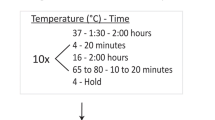Abstract
We describe a new type of molecular cloning that complements the available strategies for homologous recombinatorial cloning. Purified, linear double-stranded DNA molecules with homologous ends are simply mixed in water and they transform readily into E. coli. Insert and linear vector need as few as ten base pairs of homologous sequence at their ends and essentially no incubation or enzyme treatments are needed for creating recombinants from linear fragments. Our method outcompetes most existing cloning methods in simplicity and affordability and is well-suited for high-throughput applications.




Similar content being viewed by others
References
Festa, F., Steel, J., Bian, X., & Labaer, J. (2013). High-throughput cloning and expression library creation for functional proteomics. Proteomics, 13, 1381–1399.
Li, M. Z., & Elledge, S. J. (2007). Harnessing homologous recombination in vitro to generate recombinant DNA via SLIC. Nature Methods, 4, 251–256.
Engler, C., Kandzia, R., & Marillonnet, S. (2008). A one pot, one step, precision cloning method with high throughput capability. PLoS One, 3, e3647.
Tillett, D., & Neilan, B. A. (1999). Enzyme-free cloning: A rapid method to clone PCR products independent of vector restriction enzyme sites. Nucleic Acids Research, 27, e26.
Aslanidis, C., & de Jong, P. J. (1990). Ligation-independent cloning of PCR products (LIC-PCR). Nucleic Acids Research, 18, 6069–6074.
Klock, H. E., Koesema, E. J., Knuth, M. W., & Lesley, S. A. (2008). Combining the polymerase incomplete primer extension method for cloning and mutagenesis with microscreening to accelerate structural genomics efforts. Proteins, 71, 982–994.
Gibson, D. G., Young, L., Chuang, R.-Y., Venter, J. C., Hamilton, C. A, I. I. I., & Smith, H. O. (2009). Enzymatic assembly of DNA molecules up to several hundred kilobases. Nature Methods, 6, 343–347.
De Jong, R. N., Daniëls, M. A., Kaptein, R., & Folkers, G. E. (2006). Enzyme free cloning for high throughput gene cloning and expression. Journal of Structural and Functional Genomics, 7, 109–118.
Jeong, J.-Y., Yim, H.-S., Ryu, J.-Y., Lee, H. S., Lee, J.-H., Seen, D.-S., et al. (2012). One-step sequence- and ligation-independent cloning as a rapid and versatile cloning method for functional genomics studies. Applied and Environmental Microbiology, 78, 5440–5443.
Gibson, D. G. (2011). Enzymatic assembly of overlapping DNA fragments. Methods in Enzymology, 498, 349–361.
Stevenson, J., Krycer, J. R., Phan, L., & Brown, A. J. (2013). A practical comparison of ligation-independent cloning techniques. PLoS One, 8, e83888.
Green, M. R., & Sambrook, J. (2012). Molecular cloning: A laboratory manual (4th ed.). Cold Spring Harbor, NY: Cold Spring Harbor Laboratory Press.
Yanisch-Perron, C., Vieira, J., & Messing, J. (1985). Improved M13 phage cloning vectors and host strains: Nucleotide sequences of the M13mp18 and pUC19 vectors. Gene, 33, 103–119.
Strauch, M. A., Spiegelman, G. B., Perego, M., Johnson, W. C., Burbulys, D., & Hoch, J. A. (1989). The transition state transcription regulator abrB of Bacillus subtilis is a DNA binding protein. The EMBO Journal, 8, 1615–1621.
Mumberg, D., Müller, R., & Funk, M. (1995). Yeast vectors for the controlled expression of heterologous proteins in different genetic backgrounds. Gene, 156, 119–122.
Engler, C., Gruetzner, R., Kandzia, R., & Marillonnet, S. (2009). Golden Gate shuffling: A one-pot DNA shuffling method based on type IIs restriction enzymes. PLoS One, 4, e5553.
Gaillard, C., & Strauss, F. (1994). Association of poly(CA)·poly(TG) DNA fragments into four-stranded complexes bound by HMG1 and 2. Science, 264, 433–436.
Neschastnova, A. A., Markina, V. K., Popenko, V. I., Danilova, O. A., Sidorov, R. A., Belitsky, G. A., et al. (2002). Mechanism of spontaneous DNA–DNA interaction of homologous linear duplexes. Biochemistry, 41, 7795–7801.
Li, C., Wen, A., Shen, B., Lu, J., Huang, Y., & Chang, Y. (2011). FastCloning: A highly simplified, purification-free, sequence- and ligation-independent PCR cloning method. BMC Biotechnology, 11, 92.
Aslanidis, C., de Jong, P. J., & Schmitz, G. (1994). Minimal length requirement of the single-stranded tails for ligation-independent cloning (LIC) of PCR products. Genome Research, 4, 172–177.
Marsischky, G., & LaBaer, J. (2004). Many paths to many clones: A comparative look at high-throughput cloning methods. Genome Research, 14, 2020–2028.
Acknowledgments
Prof. Lloyd Ruddock and Prof. Linda M. Hendershot are kindly acknowledged for providing DNA constructs.
Author information
Authors and Affiliations
Corresponding author
Electronic supplementary material
Below is the link to the electronic supplementary material.
Rights and permissions
About this article
Cite this article
Koskela, E.V., Frey, A.D. Homologous Recombinatorial Cloning Without the Creation of Single-Stranded Ends: Exonuclease and Ligation-Independent Cloning (ELIC). Mol Biotechnol 57, 233–240 (2015). https://doi.org/10.1007/s12033-014-9817-2
Published:
Issue Date:
DOI: https://doi.org/10.1007/s12033-014-9817-2




